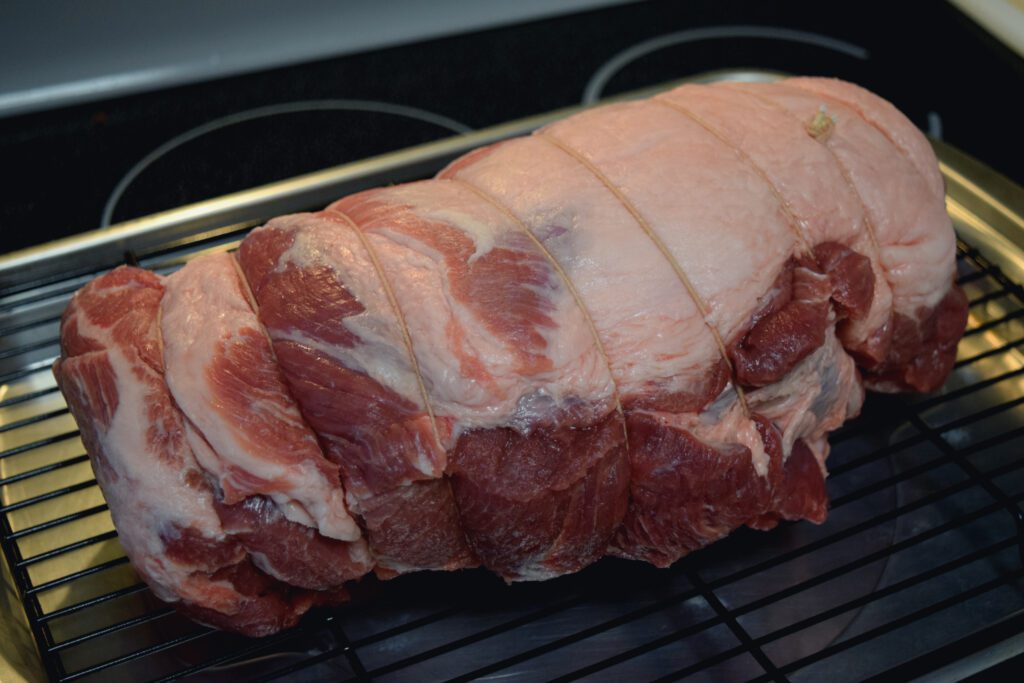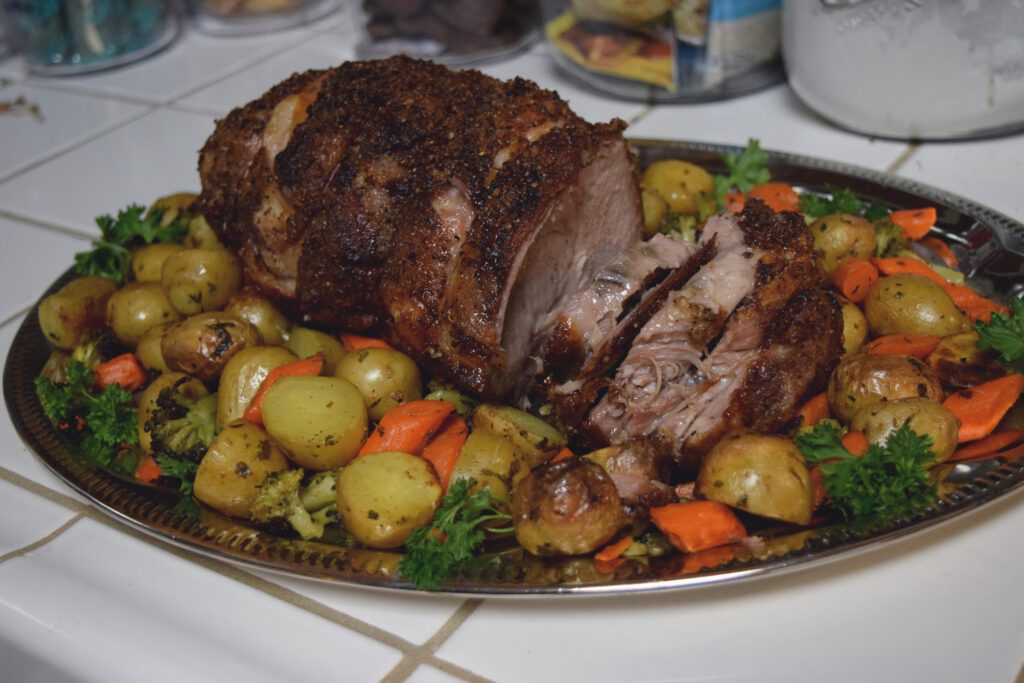How Long To Smoke A Pork Butt At 250? Determining The Ideal Cooking Time And Internal Temperature For Perfectly Smoked Pork Butt
Introduction
For barbecue lovers, the perfect smoked pork butt is one of the holy grails of cooking. Achieving that melt-in-your-mouth texture and juicy flavor is no easy feat. To accomplish this, it’s important to understand the ideal cooking time and internal temperature for a perfectly smoked pork butt.
Benefits Of Slow Smoking Pork Butt At 250°F
The secret to achieving delicious smoked pork butt is to cook low and slow. 250°F is the ideal temperature because it’s hot enough to cook the meat thoroughly, but cool enough to allow it to cook slowly. This slow cooking process allows the fat to render and the collagen to break down, resulting in a succulent, tender texture that falls apart effortlessly.
Factors That Affect Cooking Time
Determining the cooking time for your pork butt can be a little tricky, as there are several factors that can affect it. These include:
- The size of your pork butt: Larger pieces of meat will naturally take longer to cook than smaller ones.
- The amount of fat marbled throughout the meat: Fattier cuts require a longer cooking time to render the fat and yield tender meat.
- The type of smoker and heat source used: Different styles of smokers and types of fuel can have varying effects on cooking time.
It’s important to resist the temptation to rush the process by increasing the temperature or reducing the cooking time. Low and slow is the key to achieving mouth-watering pork butt that your friends and family will rave about. By understanding how to smoke a pork butt at 250°F, you’ll be well on your way to perfecting your BBQ technique and serving up delicious smoked pork butt.
Preparing The Pork Butt
Selecting The Right Cut And Seasoning
When it comes to selecting the perfect pork butt for smoking, it’s important to choose a piece with a good amount of fat marbling throughout the meat. This will ensure that the meat is tender and juicy after cooking. It’s also important to season the pork butt generously with a dry rub before smoking. This helps to enhance the flavor and create a delicious outer crust.
Trimming Excess Fat For Even Cooking
While a certain amount of fat is necessary for a flavorful pork butt, it’s important to trim any excess fat from the meat to ensure even cooking. Leaving too much fat on the meat can result in some parts of the pork butt cooking more quickly than others, leading to an uneven texture. A good rule of thumb is to leave around a quarter-inch layer of fat on the meat.
Once the pork butt is seasoned and trimmed to your liking, it’s time to start smoking! By following the ideal cooking time and internal temperature for smoked pork butt at 250°F, you’ll be well on your way to achieving a mouth-watering and delicious smoked pork butt.


Smoking Equipment Needed
Overview Of Necessary Smoking Equipment
To smoke a pork butt at 250°F, you’ll need a few key pieces of equipment. First and foremost, you’ll need a smoker. There are many different types of smokers available on the market, ranging from electric to charcoal to propane. The best type of smoker for you will depend on your personal preferences and cooking style. It’s also important to have a reliable meat thermometer on hand, as well as some heavy-duty aluminum foil for wrapping the pork butt during smoking.
Types Of Wood Chips To Use For Flavor
Another important piece of equipment when smoking a pork butt is the wood chips used for flavoring. Different types of wood chips can impart unique flavors to the meat. Some popular options include hickory, apple, and mesquite. It’s important to soak the wood chips in water for at least 30 minutes before adding them to the smoker, as this helps to create a more consistent smoke throughout the cooking process.
Overall, smoking a pork butt at 250°F requires patience, attention to detail, and the right equipment. By selecting the right cut of meat, seasoning it correctly, and using the right smoking equipment, you’ll be well on your way to achieving a mouth-watering and delicious smoked pork butt.
Preparing The Smoker
When smoking a pork butt at 250°F, it’s crucial to prepare your smoker properly for the best results. This includes cleaning and seasoning the smoker, as well as adjusting the vents and temperature control.
Cleaning And Seasoning The Smoker
Before use, it’s important to clean your smoker according to the manufacturer’s instructions. This may involve emptying the ash pan, scrubbing the grates, and washing the interior with warm soapy water. Once clean, it’s recommended to season the smoker by coating the interior with vegetable oil or spray and running it at a high temperature for a brief period of time. This helps to create a non-stick surface that enhances the flavor of the meat.
Adjusting The Vents And Temperature Control
To achieve a consistent temperature of 250°F, it’s important to adjust the vents and temperature control of your smoker accordingly. Begin by adding an appropriate amount of wood chips to the smoker box, then light the burners or ignite the coals and allow them to come to temperature. Use a meat thermometer to monitor the temperature inside the smoker, adjusting the vents as needed to maintain a steady temperature of 250°F.
Overall, by properly preparing your smoker and paying close attention to the temperature and smoke levels, you can achieve a delicious smoked pork butt at 250°F.
Smoking The Pork Butt
With the smoker properly prepared, it’s time to start smoking the pork butt. Before placing the meat on the smoker, it’s important to ensure it’s properly seasoned with mustard and a sweet rub. Once seasoned, use the following techniques for placing the meat on the smoker for optimal results.
Techniques For Placing The Meat On The Smoker
It’s recommended to place the pork butt on the smoker with the fat cap facing up. This allows the juices to penetrate the meat, resulting in a tender and flavorful finished product. Additionally, some smokers may require the meat to be placed on a rack or tray, so be sure to check the manufacturer’s instructions.
Maintaining A Consistent Temperature For Slow Cooking
To achieve the desired slow cooking at 250°F, it’s important to maintain a consistent temperature throughout the smoking process. This can be accomplished by frequently monitoring the temperature inside the smoker and adjusting the vents as needed. It’s also important to ensure a steady supply of wood chips or charcoal to maintain a consistent level of smoke throughout the smoking process.
Overall, smoking a pork butt at 250°F is a slow and patient process that requires proper preparation and attention to detail. By following these techniques and maintaining a consistent temperature, you can achieve a delicious and tender smoked pork butt.
Monitoring The Internal Temperature
To ensure that the smoked pork butt is cooked to perfection, it’s important to monitor its internal temperature throughout the process. Here are some tips for using a meat thermometer to check for doneness.
Using A Meat Thermometer To Check Doneness
A meat thermometer is a crucial tool for monitoring the internal temperature of the pork butt. Insert the thermometer into the thickest part of the meat, being careful not to touch the bone. The temperature should be checked about every hour to ensure it reaches the appropriate level of doneness.
Recommended Temperature Range For Juicy Pork Butt
The ideal internal temperature range for smoked pork butt is between 195-203°F. At this temperature range, the meat should be tender and juicy, making it easy to shred with a fork. It’s important to note that reaching the ideal temperature range can take several hours, so patience is key when smoking pork butt at 250°F.
In conclusion, monitoring the internal temperature of the pork butt is crucial for achieving perfectly smoked meat. By using a meat thermometer and aiming for the recommended temperature range, you can ensure that your smoked pork butt is tender, juicy, and full of flavor. Keep in mind that smoking a pork butt at 250°F requires patience and attention to detail, but the end result is worth the effort.
Monitoring the Internal Temperature
To achieve the perfect smoked pork butt, monitoring its internal temperature is crucial. A meat thermometer is a necessary tool for checking the doneness of the meat throughout the process. It should be inserted into the thickest part of the pork butt, avoiding the bone, and checked every hour to ensure it reaches the ideal temperature range.
Recommended Temperature Range for Juicy Pork Butt
The recommended internal temperature range for a succulent smoked pork butt is between 195-203°F. This temperature range guarantees tender and juicy meat that is easy to shred with a fork. However, reaching the ideal temperature range can take several hours, so patience is key when smoking pork butt at 250°F.
Resting and Serving
After the pork butt reaches the desired internal temperature, it’s crucial to let it rest for at least an hour before slicing or pulling. Resting allows the juices to redistribute throughout the meat, enhancing its tenderness and flavor.
Importance of Resting the Meat before Slicing
Resting the meat is essential as it helps prevent the juices from running out when you slice it. The resting process allows the meat to contract, which traps the juices inside and ensures that every bite is juicy and full of flavor.
Serving Suggestions and Pairing with Sides
When it comes to serving smoked pork butt, various sides go well with it, including coleslaw, mac and cheese, baked beans, roasted vegetables, and cornbread. Serving it with a delicious sauce or barbecue seasoning can enhance its flavor, making it a perfect centerpiece for any special occasion.
In conclusion, monitoring the internal temperature of the pork butt is crucial for achieving perfectly smoked meat. By using a meat thermometer and aiming for the recommended temperature range, you can ensure that your smoked pork butt is juicy, tender, and full of flavor. Remember to rest the meat before slicing it and serve it with a selection of delicious sides and sauce or seasoning for a mouth-watering entrée.
Troubleshooting Common Issues
Identifying And Fixing Common Smoking Problems
While smoking pork butt, several common issues can arise, leading to unsatisfactory results. One of the most common problems is the smoker’s temperature fluctuation, which can affect the meat’s overall cook time and flavor. To avoid this, ensure that you have enough fuel and check the smoker’s temperature regularly.
Another issue that can occur is the formation of a hard or rubbery crust on the meat’s surface. This happens when there is too much smoke or heat exposure on the meat’s surface. To fix this, wrap the pork butt with foil or butcher paper to prevent further smoke exposure but ensure that it continues to cook.
Tips For Avoiding Over Or Undercooking
To avoid overcooking, which can result in dry and tough meat, ensure that the meat thermometer is set to the recommended temperature range and check the pork butt regularly to prevent it from getting too dry.
To avoid undercooking, which can result in a chewy and unsafe meat, continue cooking the pork butt until it reaches the recommended internal temperature range, even if you think it’s done. Remember that different cuts of pork may have varying cook times, so it’s essential to monitor the internal temperature regularly.


In conclusion, smoking pork butt at 250°F requires patience, practice, and the right tools, such as a meat thermometer and foil or butcher paper. By identifying and fixing common smoking problems and avoiding over or undercooking, you can achieve perfectly smoked pork butt that is tender, juicy, and full of flavor.
Conclusion
Summary Of Tips For Smoking Pork Butt At 250°F
When smoking pork butt at 250°F, there are several key tips to keep in mind to ensure that the meat is tender and flavorful:
- Maintain a consistent temperature by checking the smoker’s fuel and temperature regularly.
- Wrap the pork butt with foil or butcher paper if a hard or rubbery crust forms on the surface.
- Use a meat thermometer to avoid over or undercooking the pork butt and monitor the internal temperature regularly.
By following these tips, you can achieve perfectly smoked pork butt that is melt-in-your-mouth delicious.
Additional Resources For Perfecting Your Smoking Technique
If you’re looking to improve your smoking technique, there are several additional resources available:
- Online forums such as Reddit’s r/smoking or the BBQ Brethren forum offer a wealth of knowledge and advice from experienced smokers.
- BBQ cookbooks such as “Franklin Barbecue: A Meat-Smoking Manifesto” by Aaron Franklin and Jordan Mackay or “Meathead: The Science of Great Barbecue and Grilling” by Meathead Goldwyn offer in-depth information on smoking techniques and recipes.
- YouTube channels such as BBQ with Franklin or T-ROY Cooks provide video tutorials and demonstrations for smoking techniques.
By utilizing these resources, you can continue to hone your smoking skills and perfect your signature BBQ dish.
Q: What is the ideal temperature to smoke a pork butt?
A: The ideal temperature to smoke a pork butt is 250°F.
Q: Why is it important to smoke a pork butt at 250°F?
A: Smoking a pork butt at 250°F ensures that the meat is cooked properly and evenly, allowing the juices to redistribute throughout the meat enhancing its tenderness and flavor.
Q: How long does it take to smoke a pork butt at 250°F?
A: Typically, it takes around 1.5 to 2 hours per pound of meat to smoke a pork butt at 250°F, so a 10-pound pork butt would take approximately 15-20 hours to smoke at this temperature.
Q: Is it necessary to use yellow mustard when smoking a pork butt?
A: While it’s not necessary to use yellow mustard when smoking a pork butt, it can be helpful in making the rub stick to the meat.
Q: What tools do I need to smoke a pork butt at 250°F?
A: You will need a smoker, a meat thermometer, good quality wood chips or chunks, and a pork butt.
Q: Can I smoke a boneless pork butt?
A: Yes, you can smoke a boneless pork butt. However, bone-in pork butt is recommended as it adds flavor and helps retain moisture during the smoking process.
Q: How can I ensure that my pork butt is perfectly smoked?
A: To ensure that your pork butt is perfectly smoked, make sure to use the right amount of smoke and heat, monitor the internal temperature of the meat, and allow it to rest after smoking to allow the juices to redistribute.



Hey there! If you’re a fan of authentic Mexican cuisine, you’re in for a treat with Humberto Cruz at pointcafeny.com. They take immense pride in serving their customers with home-cooked, genuine Mexican dishes crafted with the finest ingredients. From flavorful salsa to mouthwatering tamales and enchiladas, they offer an experience that brings the taste of family food from back home right to your table. Don’t forget to check out their tempting Daily Specials for a delightful culinary adventure!
